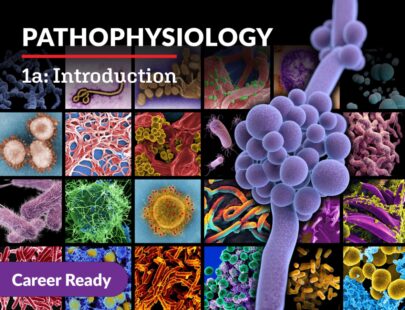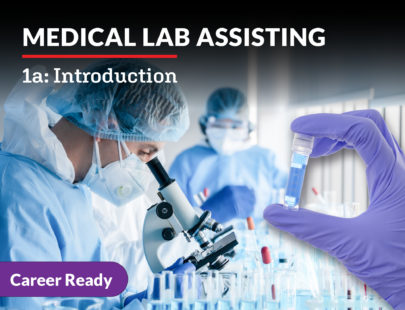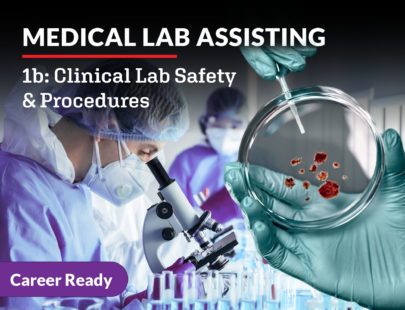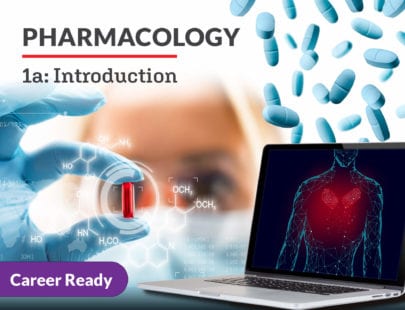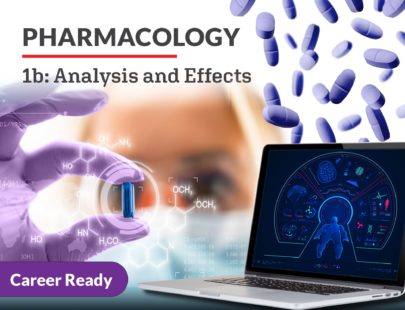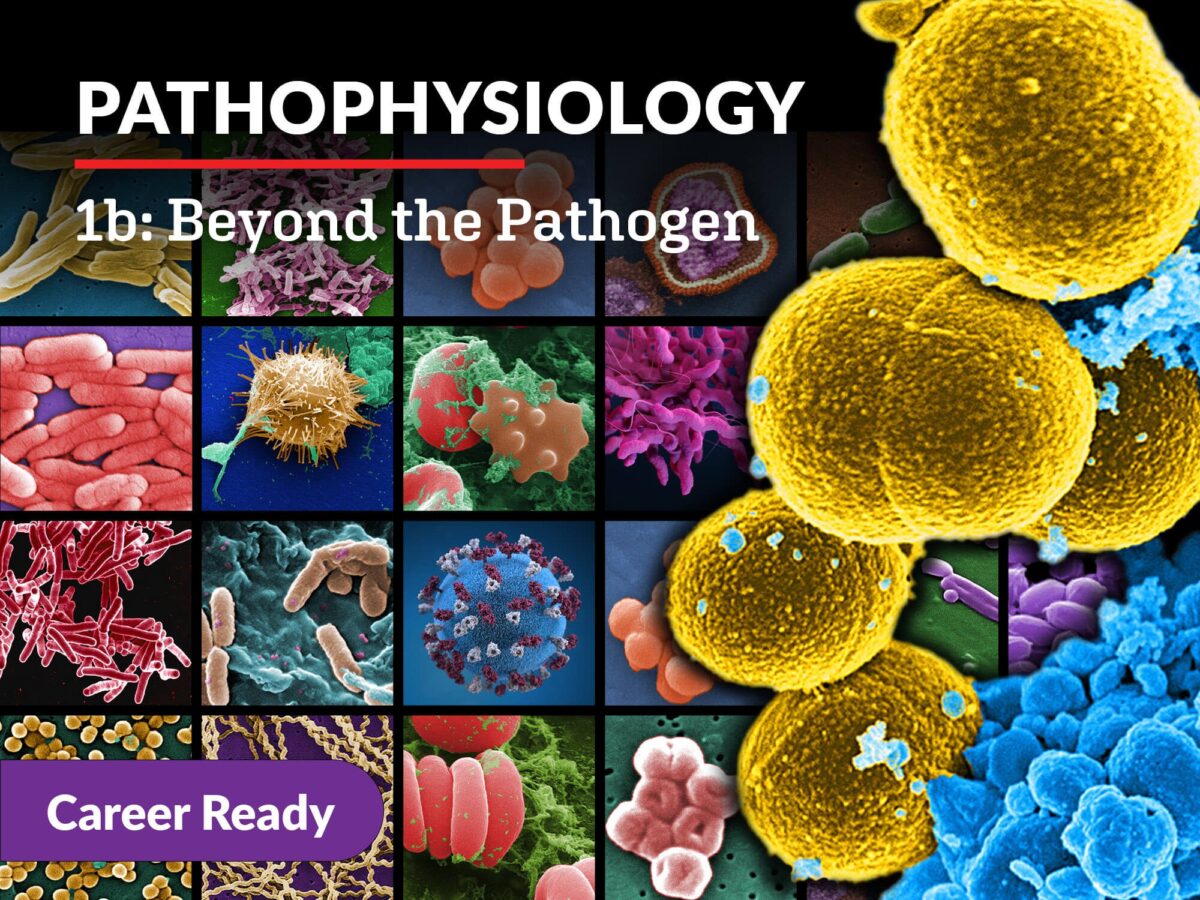
Pathophysiology 1b: Beyond the Pathogen
Now that you have a basic understanding of pathophysiology, it’s time to turn up the magnification on your microscope and get a good look at the most common body system disorders and diseases. In this course, you will examine the pathologies of common causes of mortality as well as other pervasive concerns tackling diagnosis, treatment, and prevention. You will investigate factors that contribute to disease like age, gender, heredity, and lifestyle, and then you’ll go global, looking at worldwide environmental concerns and world health challenges. Crank that magnification and let’s continue your exploration of this exciting science.
Units at a Glance
Unit 1: Normal Physiological Mechanisms
Most people use light switches automatically; without a thought, they flip the switch and expect the light to come on. When things happen so reliably it is easy to not really think about how they work. But no doubt a person would notice if they flipped the switch and nothing happened! This might make them pause to investigate the problem.
How often do we only pay attention when things stop working? What if malfunctions are really opportunities for us to pause and gain understanding of correct function? For example, could understanding the malfunctions of the body allow us to see how it is supposed to work? This unit introduces malfunctions of the human body that might give us a deeper understanding of pathophysiology.
What will you learn in this unit?
- Define homeostasis and the cells’ responses to stress
- Summarize the inflammation process including the creation of prostaglandins
- Identify the types of blood vessels and how the body controls them
- Explain the forms and forces that create and move body fluids
- Describe the methods of making ATP and controlling pH within the body
Unit 2: Respiratory Pathology
What is the longest you have ever held your breath? Did it become more difficult the longer you went? What did it feel like when you started breathing again? Try to imagine the feeling of not being able to get enough air. As you will learn, respiratory pathologies can change what daily life is like. Don’t hold your breath—now is the time to see these conditions in action!
What will you learn in this unit?
- Summarize the respiratory structures and functions
- Explain the physiological and pharmaceutical methods of respiratory control
- Describe the pathophysiology of asthma and cystic fibrosis
- Identify COPD conditions and contrast them with other respiratory conditions
- Detail the processes of pneumothorax and pleural effusion
Unit 3: Cardiovascular Pathology
Here is a challenge: name your favorite song about the kidneys. How about this one: which liver emoji do you use the most? When it comes to organs in pop culture, few even come close to the heart. The heart is that consistent workhorse that quite literally keeps the body alive, so all the attention is well earned. But just like any heartbreak song lyric will tell you, sometimes things go wrong. Ready to talk about heartache?
What will you learn in this unit?
- Identify essential cardiovascular anatomical structures and their functions
- Detail the mechanisms controlling heart contraction and arrhythmias
- Summarize the pathologies of the body’s blood vessels
- Describe the types of congenital heart defects and pathophysiology of lupus
- Analyze the body effects of myocardial infarction and heart failure
Unit 4: Endocrine and Metabolic Pathologies
Today, you will be responsible for building a house; however, while you must remain on Earth, the house is being built on Mars. By only sending signals to the distant building site, you are expected to have the house built and functioning properly. This may seem like a difficult task, but it is essentially the daily job of the endocrine system. It’s time to venture into the space where things can go wrong.
What will you learn in this unit?
- Describe the physiologic mechanisms controlling the body’s endocrine functions
- Identify the types, presentations, and complications of diabetes mellitus
- Explain the functions of hormones involved in controlling blood chemistry
- Summarize the complications resulting from diminished gonadal hormones levels
Unit 5: Oncology
Imagine you are a cell looking in the mirror. Everything looks familiar, but there something is dreadfully wrong. You then realize that what actually stands before you is a mutated version of you. It has been altered and no longer acts like you. A second disturbing realization sinks in as you take a look around; there are thousands of copies of this mutant cell surrounding you. How did this happen and what can be done?
What will you learn in this unit?
- Describe the phases and control methods of the cell cycle
- Detail the history of cancer and the process of carcinogenesis
- Contrast the normal cellular functions with those found in cancer cells
- Summarize tumor classifications and cancer treatments
- Identify methods to detect and prevent cancer
Unit 6: The Dynamic Nervous System
You have a decision before you. There is a complex mechanism that you need to understand, and there are two sets of instructions. The first describes the actual functioning of the mechanism, but it is in a language you can’t understand. The second is a relatable narrative story, but it is not fully accurate. Given the choice, which would you choose? Finding the truth behind how the nervous system functions will require you to walk the line between what is familiar and what is unknown. Are you ready for the journey?
What will you learn in this unit?
- Describe the electrochemical mechanisms of the nervous system
- Summarize alterations in motor, sensory, and information processing
- Explain the destructive natures of multiple sclerosis, myasthenia gravis, and stroke
- Identify the pathophysiology present in chronic neural degeneration disorders
- Contrast and recognize the characteristics of different mental illnesses
Unit 7: Public Health Concerns
You see her every day, the woman in your neighborhood walking her dog. She, like so many other people, makes up part of the community you live in. Even though you do not know her, her life impacts you. Thinking about the health of the world starts with extending our considerations to those in our communities. If we can learn to care about strangers, appreciating the role we all play in the health of the world becomes a little easier.
What will you learn in this unit?
- Describe the healing process and the factors that can interfere with it
- Summarize the nature of pollution and its health effects on the body
- Identify common toxins and the methods to limit exposures
- Explain global health threats and proposed solutions
Unit 8: Choosing Wellness
Imagine you are reading a letter from the future that provides specific instructions for how to live well for another 100 years. Some of these instructions are a little tough to follow, but you are assured that compliance will lead to greater health. Would you follow the guidance of the letter? The actions you take today will have a major impact on your future life; having even a glimpse at how the present and future are connected be very useful.
What will you learn in this unit?
- Identify the physiologic and cultural barriers to personal change
- Summarize the impact that stress, hormones, and hydration have on aging
- Detail nutritional issues common in the United States and the means to overcome them
- Explain the purpose and methods of effective physical activity
Required Materials Coming Soon!
Physical
- Video recording device
Software
- Graphic design software
- Word processing software
Optional
- Art supplies
- Digital camera
- Audio recording device
- Poster board
- Presentation software
- Printer
